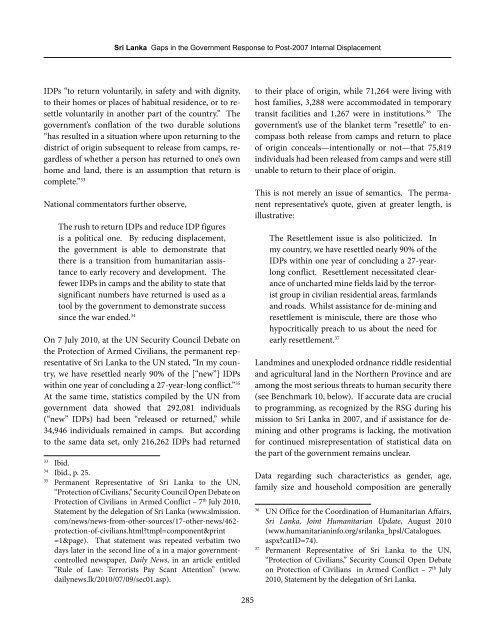From Responsibility to Response: Assessing National - Brookings
From Responsibility to Response: Assessing National - Brookings
From Responsibility to Response: Assessing National - Brookings
Create successful ePaper yourself
Turn your PDF publications into a flip-book with our unique Google optimized e-Paper software.
Sri Lanka Gaps in the Government <strong>Response</strong> <strong>to</strong> Post-2007 Internal Displacement<br />
IDPs “<strong>to</strong> return voluntarily, in safety and with dignity,<br />
<strong>to</strong> their homes or places of habitual residence, or <strong>to</strong> resettle<br />
voluntarily in another part of the country.” The<br />
government’s conflation of the two durable solutions<br />
“has resulted in a situation where upon returning <strong>to</strong> the<br />
district of origin subsequent <strong>to</strong> release from camps, regardless<br />
of whether a person has returned <strong>to</strong> one’s own<br />
home and land, there is an assumption that return is<br />
complete.” 33<br />
<strong>National</strong> commenta<strong>to</strong>rs further observe,<br />
The rush <strong>to</strong> return IDPs and reduce IDP figures<br />
is a political one. By reducing displacement,<br />
the government is able <strong>to</strong> demonstrate that<br />
there is a transition from humanitarian assistance<br />
<strong>to</strong> early recovery and development. The<br />
fewer IDPs in camps and the ability <strong>to</strong> state that<br />
significant numbers have returned is used as a<br />
<strong>to</strong>ol by the government <strong>to</strong> demonstrate success<br />
since the war ended. 34<br />
On 7 July 2010, at the UN Security Council Debate on<br />
the Protection of Armed Civilians, the permanent representative<br />
of Sri Lanka <strong>to</strong> the UN stated, “In my country,<br />
we have resettled nearly 90% of the [“new”] IDPs<br />
within one year of concluding a 27-year-long conflict.” 35<br />
At the same time, statistics compiled by the UN from<br />
government data showed that 292,081 individuals<br />
(“new” IDPs) had been “released or returned,” while<br />
34,946 individuals remained in camps. But according<br />
<strong>to</strong> the same data set, only 216,262 IDPs had returned<br />
33 Ibid.<br />
34 Ibid., p. 25.<br />
35 Permanent Representative of Sri Lanka <strong>to</strong> the UN,<br />
“Protection of Civilians,” Security Council Open Debate on<br />
Protection of Civilians in Armed Conflict – 7 th July 2010,<br />
Statement by the delegation of Sri Lanka (www.slmission.<br />
com/news/news-from-other-sources/17-other-news/462protection-of-civilians.html?tmpl=component&print<br />
=1&page). That statement was repeated verbatim two<br />
days later in the second line of a in a major governmentcontrolled<br />
newspaper, Daily News, in an article entitled<br />
“Rule of Law: Terrorists Pay Scant Attention” (www.<br />
dailynews.lk/2010/07/09/sec01.asp).<br />
285<br />
<strong>to</strong> their place of origin, while 71,264 were living with<br />
host families, 3,288 were accommodated in temporary<br />
transit facilities and 1,267 were in institutions. 36 The<br />
government’s use of the blanket term “resettle” <strong>to</strong> encompass<br />
both release from camps and return <strong>to</strong> place<br />
of origin conceals—intentionally or not—that 75,819<br />
individuals had been released from camps and were still<br />
unable <strong>to</strong> return <strong>to</strong> their place of origin.<br />
This is not merely an issue of semantics. The permanent<br />
representative’s quote, given at greater length, is<br />
illustrative:<br />
The Resettlement issue is also politicized. In<br />
my country, we have resettled nearly 90% of the<br />
IDPs within one year of concluding a 27-yearlong<br />
conflict. Resettlement necessitated clearance<br />
of uncharted mine fields laid by the terrorist<br />
group in civilian residential areas, farmlands<br />
and roads. Whilst assistance for de-mining and<br />
resettlement is miniscule, there are those who<br />
hypocritically preach <strong>to</strong> us about the need for<br />
early resettlement. 37<br />
Landmines and unexploded ordnance riddle residential<br />
and agricultural land in the Northern Province and are<br />
among the most serious threats <strong>to</strong> human security there<br />
(see Benchmark 10, below). If accurate data are crucial<br />
<strong>to</strong> programming, as recognized by the RSG during his<br />
mission <strong>to</strong> Sri Lanka in 2007, and if assistance for demining<br />
and other programs is lacking, the motivation<br />
for continued misrepresentation of statistical data on<br />
the part of the government remains unclear.<br />
Data regarding such characteristics as gender, age,<br />
family size and household composition are generally<br />
36 UN Office for the Coordination of Humanitarian Affairs,<br />
Sri Lanka, Joint Humanitarian Update, August 2010<br />
(www.humanitarianinfo.org/srilanka_hpsl/Catalogues.<br />
aspx?catID=74).<br />
37 Permanent Representative of Sri Lanka <strong>to</strong> the UN,<br />
“Protection of Civilians,” Security Council Open Debate<br />
on Protection of Civilians in Armed Conflict – 7 th July<br />
2010, Statement by the delegation of Sri Lanka.

















